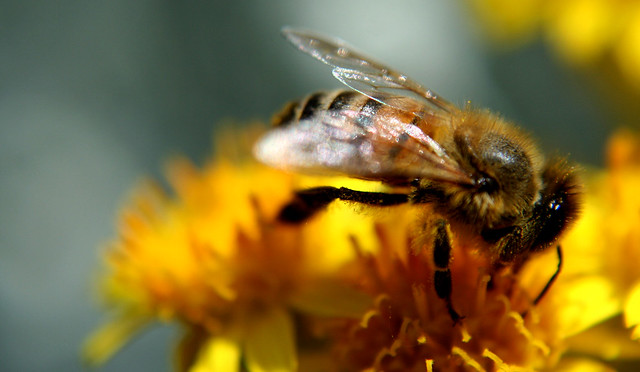
flickr CC/Kevin Labianco
If Germany, France, Italy, and Slovenia have banned Clothianidin, a pesticide which harms the central nervous system of insects and is known by the EPA to significantly harm the honeybee, why is it not banned here in the United States?
One can't help but be confused by the multitude of headlines over these past several years which have claimed to know (or not know) the cause of Colony Collapse Disorder, or CCD. Luckily, I have a friend here in Boulder who raises bees and is connected to other beekeepers and real world experts who are carefully watching the honeybee decline story. They believe that a new Purdue study is very important and significant, which implicates the insecticide class of neonicotinoids: Multiple Routes of Pesticide Exposure for Honey Bees Living Near Agricultural Fields.
When you visit Wikipedia's neonicotinoid page, it begins,
"Neonicotinoids are a class of insecticides which act on the central nervous system of insects with lower toxicity to mammals. Neonicotinoids are among the most widely used insecticides worldwide, but recently the uses of some members of this class have been restricted in some countries due to a possible connection to honey-bee colony collapse disorder, though no scientific evidence has been established confirming that connection."
This Wikipedia page needs updated, since scientific evidence certainly has been established with this Purdue study and had already been well-established by this 2010 EPA (PDF) leakeddocument. For an explanation of this class of insecticides, this is from Mid-Atlantic Apiculture Research and Education: While imidacloprid, registered in 1992, is the best-known insecticide in this class, there have been a number of new neonicotinoids introduced since then (clothianidin, acetamiprid, thiamethoxam, etc.). Their use has increased dramatically over the past few years and they are now the most widely used group of insecticides in the U.S. Their many uses include: seed treatments for corn, cotton, canola and sunflowers; foliar sprays of fruit, vegetable, nut and coffee crops; granular, and liquid drench applications in turf, ornamentals, fruit crops and in forests; and in California the number one use of imidacloprid is for the control of structural pests. The EPA identifies both imidacloprid and clothianidin as highly toxic to honey bees. For example: “Clothianidin is highly toxic to honey bees on an acute contact basis (LD50 > 0.0439 μg/bee). Now back to the newly released Purdue study. I've listed two excerpts:
1. Results of analyses of these bees and pollen from the hives revealed that both clothianidin and thiamethoxam were present on dead bees and in pollen collected from a single hive. These compounds were also present in dead bees from other hives but not in bees from hives that did not show mortality.
2. Our results also demonstrate that clothianidin is present in the surface soil of agricultural fields long after treated seed has been planted in that field. All soil samples we collected contained clothianidin, even in cases where no treated seed had been planted for 2 growing seasons. During the spring planting period, dust that arises from this soil may land on flowers frequented by bees, or possibly on the insects themselves. Of potentially greater concern are the very high levels of neonicotinoids (and fungicides) found in the talc that has been exposed to treated seed, since part of this highly mobile material is exhausted to the outside environment during planting and after planting.Clothianidin, sold by Bayer, generated $262 million in sales in 2009 to farmers. Imidacloprid, also by Bayer, has annual sales of nearly $860 million. Also, you may have heard the widely publicized recent news item, where a Chinese scientist is being sent to prison for seven years for stealing DOW and Cargill research secrets. The information which he stole concerned Spinosad, which is an "organic insecticide" derived from soil bacteria that disrupts the central nervous system of pests and insects. This information was valued at roughly $7-20 million dollars. According to Wikipedia, Spinosads . . .
show slight toxicity to birds, moderate toxicity to fish, and slight to moderate toxicity to aquatic invertebrates.However, it is highly toxic to bees (honey bee LC50 = 11.5 ppm) and is highly toxic to oysters and other marine mollusks. Applications to areas where bees are actively foraging should be avoided. After the residues have dried, it is much less toxic to bees.Yes, you did read that right, the Spinosad class of insecticide has been approved for use on U.S. certified organic produce and it is highly toxic to the honeybee. As for avoiding applications where bees are actively foraging, where might that be and who's watching? Fruits, vegetables, and nuts all require pollination. Pollinators are responsible for pollination of approximately one third of the United States' crop species, including almonds, peaches, soybeans, apples, pears, cherries, raspberries, blackberries, cranberries, watermelons, cantaloupes, cucumbers and strawberries. Insect neurotoxins that destroy honeybees are doing what to our soil health? our birds? ourselves? and our food supply? ——Kay McDonald
Thank you to Laura Tyler @lauraloveslux for pointing me to this Purdue study. She is a documentary filmmaker who created the film Sister Bee. In the fall of 2007, PBS Nature produced the following show describing Colony Collapse Disorder. It discusses pesticides, nutrition, and the Israeli acute paralysis virus (IAPV). It visits Sichuan province in China where humans pollinate pear trees by hand because over-zealous use of pesticides previously has entirely decimated the bee population of the region. It is stated that at the current rate of decline, there will be no bees left by 2035.
Watch Silence of the Bees on PBS. See more from Nature.




No comments:
Post a Comment